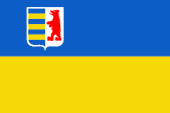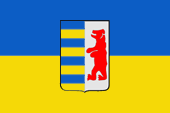Transcarpathia is since 1945 a part of the Ukraine and it is an own distrikt there. That adoped an own flag on 27th of February in 2009, which is nearly similar to the historic flag of Transcarpathia. The flag shows the colours of Ukraine and in the blue stripe the coat of arms of Transcarpathia near the pole, but not exactly in the same style how it was used from this country as it was a part of Czechoslovakia (1918–1939). That historic flag is unofficial. It is used by the in Poland and in Slovakia living Ruthenians. Ruthenians are Ukrainians, which live outside the Ukraine. In the Carpatia Mountains they are called Russins, Huzuls, Lemkes, or Bojks too.
Source: Flags of the World, Volker Preuß


historical coat of arms of Transcarpathia,
Source, by: Flags of the World

The coat of arms of Transcarpathia originate leastways from the year 1918 as this region was transfered from Hungary to Czechoslovakia, because its heraldry arised in the coat of arms of Czechoslovakia as representative of Transcarpathia and was in use there until the return to Hungary in the year 1939. The coat of arms is lengthwise divided and shows in the left field the Ukrainian colours blue and gold in fourfold duplication, but however in heraldic wrong succession. In the right field a stylized red bear on silvery ground. Its origin and meaning are unsolved, possibly it stands for the Capatia Mountains.
Source: Flags of the World

Area: 4.933 square miles
Inhabitants: 1.250.129 (2021), thereof 80 % Ukrainians, 12 % Hungarians, 3 % Romanians, 2 % Russians
Density of Population: 253 inh./sq.mi.
Capital: Uzhhorod (Slovakian: Uzhorod, Hungarian: Ungvár), 115.568 inh. (2004)
official Languages: Ukrainian, Hungarian
other Languages: Slovakian, Russian
Currency: Ukrainian currency
Time Zone: GMT + 2 h
Source:
Wikipedia (DE)

10th cent. · the region of the today’s Transcarpathia - settled by Eastern Slavonic tribes (ancestors of the Ukrainians - comes to Hungary
1541 · Johann Siegmund calls out for the Turks, Transylvania (Siebenburgen) becomes dependent from the Ottoman Empire
1688 · the parliament of Siebenburgen recognizes the supremacy of the Hungarian king and the Roman-German emperor
1697 · Battle of Karlowitz, the Turks have to cede Hungary, Slavonia, Croatia and the Principality of Siebenbuergen (and in this way the Carpato Ukraine) to the Empire of the Austrian Habsburgs
March to November 1848 · revolution in Vienna, civil war between Hungarians and Croats, riotings in Prague, Mailand and Venice, as a result of that resigns Emperor Ferdinand I. and Franz Joseph I. of Habsburg becomes new Emperor, new constitution, end of the monarchical subdivisions of the country and instead of this establishment of crown lands with own parliaments, Transcarpathia comes to Hungary, the riotings become suppressed
8th of February 1867 · Austrian-Hungarian conciliation, equal right for both parts of the country, nascence of the double monarchy of Austria-Hungary, Austria: consisting of the Austrian crown lands, Hungary: consisting of Hungary itself and its minor countries, the House of Habsburg sets in one person the Emperor of Austria and the King of Hungary, establishment of common ministries in foreign affairs, finance and defense
28th of June 1914 · assassination of the Austrian throne successor Franz Ferdinand and of his wife, onset of the First World War (1914–1918)
28th of October 1918 · the Czechoslovakia separates from Austria-Hungary, annexation of Transcarpathia by Czechoslovakia
14th of March 1939 · Slovakia separates from Czechia ab, end of Czechoslovakia, Hungary annexes Transcarpathia, Poland the region around the City of Teshen
1939–1945 · Second World War: 1944 · Transcarpathia becomes occupied by soviet troops and a little later annexedby the Soviet Union (affiliation to the Soviet Ukraine)
Source: Wikipedia (D)

The name "Carpato Ukraine" expresses the position of the country at the Carpatia Mountains and also its political affiliation, but at least the nationality of the most of its inhabitants. The word "Transcarpathia" describes the situation of the country "at the other side of the Carpatia Mountains", seen from the north, from the Ukraine. The here living Ruthenians are Ukrainians which otherwise live outside the Ukraine. In the Carpatia Mountains they are also called Russins, Huzuls, Lemkes, or Bojks.
Source:
Die Völker der Erde, Volker Preuß


![]()




![]()
